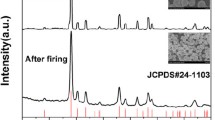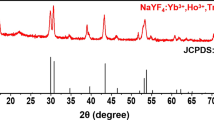Abstract
We designed and fabricated a flexible optical fiber based on LiGa4(MgGe)0.5O8:Cr phosphors with temperature-dependent fluorescence characteristics. Specifically, the full width at half maximum (FWHM) of the emission band broadens with elevated temperature due to the increased electron–phonon interactions in the matrix. Moreover, the FWHM values subtly increase with the increase in the concentration of the [Mg2+–Ge4+] unit in LiGa4(MgGe)0.5O8:Cr, along with the increase in the external quantum efficiency from 24.8% to 50.0%. Furthermore, these phosphors exhibit excellent luminescence thermal resistance, with an outstanding absolute sensitivity of 7.51 cm−1 K−1 at 443 K and a good relative sensitivity of 0.64% K−1 at 303 K. Finally, a flexible all-fiber system is employed to monitor the real-time temperature of objects with excellent repeatability, precision, and stability. This work not only explores the promising application of Cr3+-doped luminescent materials with sharp emissions but also enriches the new routes of optical temperature measurement owing to the bandwidth characteristics.

摘要
我们设计并制备了一种基于LiGa4(MgGe)0.5O8:Cr荧光粉变温发光特性的柔性温度传感光纤. 通常来说, 随着温度的升高, 发光材料基质的电子–声子作用将加剧, 这会导致其发射峰的半高宽(FWHM)在升温时不断加宽. 在本工作中, 随着LiGa5−x(MgGe)xO8:Cr中[Mg2+–Ge4+]化学单元成分比例的增加, 荧光粉近红外发光的FWHM出现明显展宽, 其外量子效率也从24.8%增加到50.0%. 进一步研究发现, LiGa4-(MgGe)0.5O8:Cr纳米荧光粉的发光具有优异的热稳定性和温度传感特性, 在443 K时绝对灵敏度可达7.51 cm−1K−1, 303 K下相对灵敏度为0.64% K−1. 基于此, 我们搭建了具有可重复性、 高精度和优异稳定性的柔性全光纤系统, 并将其用于实时监测物体的温度. 本研究不仅探索了具有锐线发射的Cr3+掺杂发光材料的应用, 而且丰富了基于荧光材料带宽特性的光学测温新思路.
Similar content being viewed by others
References
Brites CDS, Balabhadra S, Carlos LD. Lanthanide-based thermometers: At the cutting-edge of luminescence thermometry. Adv Opt Mater, 2018, 7: 1801239
Jia M, Chen X, Sun R, et al. Lanthanide-based ratiometric luminescence nanothermometry. Nano Res, 2023, 16: 2949–2967
Yu D, Li H, Zhang D, et al. One ion to catch them all: Targeted high-precision Boltzmann thermometry over a wide temperature range with Gd3+. Light Sci Appl, 2021, 10: 236
Quintanilla M, Henriksen-Lacey M, Renero-Lecuna C, et al. Challenges for optical nanothermometry in biological environments. Chem Soc Rev, 2022, 51: 4223–4242
Chen M, Wang Z, Li K, et al. Elastic and stretchable functional fibers: A review of materials, fabrication methods, and applications. Adv Fiber Mater, 2021, 3: 1–13
Zhang W, Huang X, Liu W, et al. Semiconductor plasmon enhanced upconversion toward a flexible temperature sensor. ACS Appl Mater Interfaces, 2023, 15: 4469–4476
de Souza KMN, Silva RN, Silva JAB, et al. Novel and high-sensitive primary and self-referencing thermometers based on the excitation spectra of lanthanide ions. Adv Opt Mater, 2022, 10: 2200770
Chen H, Lou Z, Shen G. An integrated flexible multifunctional sensing system for simultaneous monitoring of environment signals. Sci China Mater, 2020, 63: 2560–2569
Leber A, Cholst B, Sandt J, et al. Stretchable thermoplastic elastomer optical fibers for sensing of extreme deformations. Adv Funct Mater, 2018, 29: 1802629
Loke G, Yan W, Khudiyev T, et al. Recent progress and perspectives of thermally drawn multimaterial fiber electronics. Adv Mater, 2020, 32: 1904911
Tong Y, Feng Z, Kim J, et al. 3D printed stretchable triboelectric nanogenerator fibers and devices. Nano Energy, 2020, 75: 104973
Guo J, Zhou B, Zong R, et al. Stretchable and highly sensitive optical strain sensors for human-activity monitoring and healthcare. ACS Appl Mater Interfaces, 2019, 11: 33589–33598
Guo J, Zhou B, Yang C, et al. Stretchable and temperature-sensitive polymer optical fibers for wearable health monitoring. Adv Funct Mater, 2019, 29: 1902898
Ansari AA, Parchur AK, Nazeeruddin MK, et al. Luminescent lanthanide nanocomposites in thermometry: Chemistry of dopant ions and host matrices. Coord Chem Rev, 2021, 444: 214040
Hu T, Gao Y, Molokeev M, et al. Non-stoichiometry in Ca2Al2SiO7 enabling mixed-valent europium toward ratiometric temperature sensing. Sci China Mater, 2019, 62: 1807–1814
Kolesnikov IE, Kalinichev AA, Kurochkin MA, et al. YVO4:Nd3+ nanophosphors as NIR-to-NIR thermal sensors in wide temperature range. Sci Rep, 2017, 7: 18002
Zhou L, Du P, Li W, et al. Lithium ion doping triggered splendid quantum efficiency and thermal stability in Li2SrSiO4:xEu2+ phosphors for optical thermometry and high luminous efficiency white-LED. New J Chem, 2019, 43: 16445–16453
Marciniak Ł, Bednarkiewicz A, Hreniak D, et al. The influence of Nd3+ concentration and alkali ions on the sensitivity of non-contact temperature measurements in ALaP4O12:Nd3+ (A = Li, K, Na, Rb) nanocrystalline luminescent thermometers. J Mater Chem C, 2016, 4: 11284–11290
Zheng T, Sójka M, Runowski M, et al. Tm2+ activated SrB4O7 bifunctional sensor of temperature and pressure–Highly sensitive, multiparameter luminescence thermometry and manometry. Adv Opt Mater, 2021, 9: 2101507
Zhang W, Wang G, Cai Z, et al. Spectral analysis for broadband fluorescence: Temperature sensing with the YAG:Ce phosphor as an example. Opt Mater Express, 2016, 6: 3482–3490
Huang TH, Hsu CC, Kuo CT, et al. Ruby spectral band-profile analysis for temperature sensing. J Appl Phys, 1994, 75: 3599–3606
Zheng T, Luo L, Du P, et al. Highly-efficient double perovskite Mn4+-activated Gd2ZnTiO6 phosphors: A bifunctional optical sensing platform for luminescence thermometry and manometry. Chem Eng J, 2022, 446: 136839
Xia Z, Ma C, Molokeev MS, et al. Chemical unit cosubstitution and tuning of photoluminescence in the Ca2(Al1−xMgx)(Al1−xSi1+x)O7:Eu2+ phosphor. J Am Chem Soc, 2015, 137: 12494–12497
Xiong P, Huang B, Peng D, et al. Self-recoverable mechanically induced instant luminescence from Cr3+-doped LiGa5O8. Adv Funct Mater, 2021, 31: 2010685
Wu D, Liu L, Duan H, et al. A comparison research on replacements of Ba2+ by Lu3+ and Ba2+-Si4+ by Lu3+-Al3+ in BaSi2O2:Eu phosphors. J Rare Earth, 2022, 40: 20–28
Liu D, Li G, Dang P, et al. Simultaneous broadening and enhancement of Cr3+ photoluminescence in LiIn2SbO6 by chemical unit cosubstitution: Night-vision and near-infrared spectroscopy detection applications. Angew Chem Int Ed, 2021, 60: 14644–14649
Shannon RD. Revised effective ionic radii and systematic studies of interatomic distances in halides and chalcogenides. Acta Cryst A, 1976, 32: 751–767
Song E, Chen M, Chen Z, et al. Mn2+-activated dual-wavelength emitting materials toward wearable optical fiber temperature sensor. Nat Commun, 2022, 13: 2166
Toby BH, Von Dreele RB. GSAS-II: The genesis of a modern open-source all purpose crystallography software package. J Appl Crystlogr, 2013, 46: 544–549
Hsu JY, Chung RJ, Majewska N, et al. Probing local structural changes by sharp luminescent infrared nanophosphor for application in light-emitting diodes. Chem Mater, 2022, 34: 11093–11100
Feng X, Lin L, Duan R, et al. Transition metal ion activated near-infrared luminescent materials. Prog Mater Sci, 2022, 129: 100973
Liu G, Molokeev MS, Xia Z. Structural rigidity control toward Cr3+-based broadband near-infrared luminescence with enhanced thermal stability. Chem Mater, 2022, 34: 1376–1384
Zhao M, Liu S, Cai H, et al. Efficient broadband near-infrared phosphor Sr2ScSbO6:Cr3+ for solar-like lighting. Sci China Mater, 2022, 65: 748–756
Back M, Ueda J, Nambu H, et al. Boltzmann thermometry in Cr3+-doped Ga2O3 polymorphs: The structure matters! Adv Opt Mater, 2021, 9: 2100033
Back M, Ueda J, Xu J, et al. Effective ratiometric luminescent thermal sensor by Cr3+-doped mullite Bi2Al4O9 with robust and reliable performances. Adv Opt Mater, 2020, 8: 2000124
Xiang J, Zhou X, Zhao X, et al. Ab initio site-selective occupancy and luminescence enhancement in broadband NIR emitting phosphor Mg7Ga2GeO12:Cr3+. Laser Photonics Rev, 2023, 17: 2200965
Tang F, Ye H, Su Z, et al. Luminescence anisotropy and thermal effect of magnetic and electric dipole transitions of Cr3+ ions in Yb:YAG transparent ceramic. ACS Appl Mater Interfaces, 2017, 9: 43790–43798
Chen M, He Y, Liang H, et al. Stretchable and strain-decoupled fluorescent optical fiber sensor for body temperature and movement monitoring. ACS Photonics, 2022, 9: 1415–1424
Acknowledgements
This work was supported by the National Key Research and Development Program of China (2021YFE0105700), the National Natural Science Foundation of China (52302177 and 51972118), and the Local Innovative and Research Teams Project of Guangdong Pearl River Talents Program (2017BT01X137).
Author information
Authors and Affiliations
Contributions
Author contributions Xia Z conceived and designed the research. Wang Y performed the experiments. Jin J conducted the DFT calculations. Wang Y wrote the paper with support from Liu G. All authors contributed to the result interpretation.
Corresponding author
Ethics declarations
Conflict of interest The authors declare that they have no conflict of interest.
Additional information
Yuzhen Wang is currently engaging in her postdoctoral work at the South China University of Technology under the supervision of Prof. Zhiguo Xia. She obtained her doctorate degree from Renmin University of China in 2022. Her current research interest mainly focuses on inorganic luminescent materials for fluorescent temperature sensing.
Zhiguo Xia is a professor at the South China University of Technology. He obtained his Bachelor’s degree in 2002 and Master’s degree in 2005 from Beijing Technology and Business University, and received his PhD degree from Tsinghua University in 2008. His research interests include the discovery of new rare earth-doped solid-state luminescence materials and the new luminescent metal halides and their photonics applications.
Supplementary information Experimental details, computational method and supporting data are available in the online version of the paper.
Rights and permissions
About this article
Cite this article
Wang, Y., Jin, J., Liu, G. et al. Bandwidth-based flexible optical fiber thermometry based on sharp line emission regulation of Cr3+ ions. Sci. China Mater. 66, 4022–4029 (2023). https://doi.org/10.1007/s40843-023-2542-5
Received:
Accepted:
Published:
Issue Date:
DOI: https://doi.org/10.1007/s40843-023-2542-5




